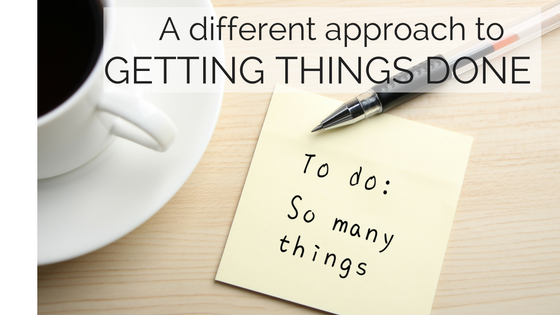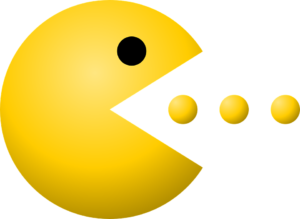
When It Is Tough to Get Going – Proven Strategies to Get Things Done
Frustrated by the gap between knowing what you should/want/need to get done and the reality of what you are actually accomplishing? For many people, this is a chronic struggle – especially those with ADD/ADHD/EF (executive function) challenges, myself included! Even when we are at the top of our game there’s still a backlog that can approach critical mass. Do you wonder what the top of your game would be if you could be more Nike-like and ‘Just Do It.’ Fortunately, there ARE strategies that help, and here are a few:
Begin with Clarity – Know exactly what you plan to do AND why you want to do it. Maybe it’s because you need to get something done, but by phrasing it as something you want (even if the reason is to keep your job, pass a course or stay on speaking terms with your partner), it becomes your CHOICE, and our motivational circuits work a lot better when we choose to do something. So convert your ‘have-to’s’ ‘must-do’s’ and ‘need-to’s’ to ‘WANT-TO’s.’
Think ‘Task’ NOT ‘Project’ – Often, what we want to do is too big to accomplish in a single sitting, leading to a feeling of overwhelm. For many of us, overwhelm is a trigger to shutting down and doing less, rather than ‘attacking’ the project to successfully accomplish it. Our brain perceives the situation as threatening, and shifts into the protective ‘fight, flight or freeze’ mode, which doesn’t help with getting things done.
Avoid overwhelm by identifying the PROJECT (it might be to redo the files, create a newsletter, plan a vacation, organize the closet, write the thesis, ‘do’ the taxes). Whatever it is,breakit down into the multiple small steps (TASKS) that are needed to complete the project.
The first task of any project is to create a written Project Sheet that specifies everything you’ll need to get it done, from resources needed (information, people, money, tools) to a step-by-step breakdown of each action, with approximations of the time you’ll need for each step – then double it (or more). Reinforce the steps by writing them down and saying them out loud. Keep the Project Sheet where you can easily refer back to it. (Think weekly and daily planning/review sessions, which take time but totally save you hours!)
Set a Conscious Intention (Commitment) – Once you are clear about WHAT you will do, decide WHEN you’ll get it done – PRIORITIZE. Put each step in your calendar or planner as a Task-Appointment, which is an appointment with yourself to work on a specific task at a specific time.
Saying ‘yes’ without saying ‘when’ is a typical precursor to not getting things done. Consider posting a reminder with the specific task you have prioritized, in a place that will draw your attention back to it when it begins to wander (and accept that it will wander!). You might want to expand your declared focus to prioritize an entire day or a week, “This week I will finish …” This doesn’t mean you won’t do other things, but it helps to swing you back to your key priority when your attention drifts or your interest wanes.
Make it Do-Able – It often helps to set a timer for a short amount of time so you don’t feel ‘trapped.’ It is easier to start something if you know you only have to stay focused on it for 20 minutes (or 15… or 10!). If you don’t complete the task within the time you’ve allotted, that’s okay. Congratulate yourself for having done what you said you would, then set additional Task-Appointments to finish what you’ve successfully begun. Take breaks between scheduled appointments. Some people find background music makes it easier to stay focused (volume and genre do matter!).
Minimize Distractions – Put on your blinders and resist temptation by making it less intrusive. Turn off email notifications, and even the phone if possible. Put a sign on your door that you will be available at 3:30 (or whenever), to minimize interruptions. Use a chalk or white board so visitors can leave messages. Give yourself permission to let go of the guilt from the other projects that need your attention, so you can successfully focus on one at a time. (I’m a brilliant multi-tasker, as long as I only work onone task at a time!)
We can’t quite turn off our brain (although a few minutes of mindful focus before you begin the work can help), so keep a ‘parking lot’ handy – a place to write down the thoughts that pop up and can compromise your focus. You don’t want to forget to make that call, send an email, pick up the dry cleaning, order a replacement phone charger, etc., and these are the things that will often pop into your mind while doing something else. You will think about it, so capture these thoughts in writing or tell it to Siri, OK Google, Alexa or your phone companion. Then you don’t need to shift your attention away from your project in order to remember to do it.
Start Small – When you are REALLY stuck, just open the notebook or computer file and look at the page or screen. Then put your pen to paper or fingers to keypad. They may start moving of their own volition. If not, commit to writing just one sentence, which often opens the gateway to moving forward. Or pull out a folder and skim the papers. Or make a list of what you think you should be doing. It’s the ACTIVATION that’s so difficult. Sometimes, all it takes is a minimal start to trigger our brains to become involved with something we’ve been avoiding. And remember how good it feels to get something done!
Take Breaks & Make Time for Self-Care – Avoid ‘overbooking.’ Often, less IS more. Leave ‘white space’ in your day. Especially when you have things to do in the evening or over the weekend. Leave time between Task-Appointments (if you work for 20 minutes, take a 5-10 minute break, then a longer break every two hours or so). Get up and MOVE (keeps the energy flowing). This is easy to forget when in hyper-focus mode, where we can work for hours on something because we are so caught up in it. Try to remember the law of diminishing returns (and ask yourself what is not getting done that is also important.
Take care of yourself! SELF-CARE is often the first thing to go when we feel there is too much to do.
Yet self-care provides the physical AND mental energy to accomplish more. Think about it – how much more cognitively alert and productive are you after a good night’s SLEEP? Multiple studies are showing that our body and brain usesleep as a time to recharge, including eliminating toxins, so it isn’t, as many feel, a ‘necessary evil,’ but part of the productive process.
We know that EXERCISE boosts our body chemistry so we are more functional (and ofter a lot less ‘hyper’ or ‘antsy’). So fit some version of it into your schedule (again, less is often more if it means you’ll actually do it – sometimes our exercise goals may be somewhat unrealistic). DRINK a lot of water (hydrate). SNACK on fruit or have a protein shake. A quick NAP or MEDITATION can be super-restorative. Science is proving that time spent OUTSIDE in greenery can dramatically enhance our mood. (The Japanese even have a concept for this called ‘Forest Bathing.’) Yet when we feel ‘behind,’ as is so typical, we deny ourselves these self-care actions that boost our brain chemistry and pay us back with increased focus and productivity.
We NEED and DESERVE to ENJOY ourselves. Take a break to play with your kids or your dog (laughter totally energizes). Pet the cat and let the purring calm your brainwaves. Allow yourself time to garden, paint, create music or anything that comforts your soul. Have lunch with friends or make some private time with your partner, and you’ll usually get MORE done – and feel less deprived or annoyed by having to do the work in the first place!
Accountability Helps – Don’t try to go it alone. Report your progress to a non-judgmental accountability-partner, whether a friend, family member or coach, or consider joining an Accountability Group. (Check out my Get Around TUIT online action group at www.OvercomeOverwhelm.com)
Here’s an accountability strategy that is especially appealing to the tech-savvy. I ask some of my coaching clients to take a photo of their progress and text it to me. It might be a completed page in their planner, homework assignment or business plan, an organized desktop, newly labeled files or an emptied suitcase from last month’s trip – whatever supports their intention at the end of our last coaching session. If they said they would join a study group, go to the library or attend a networking event, I ask for an on-location ‘selfie.’ The photo is fun, helps them to feel more motivated and gives ‘instant’ feedback as to a job well done – not from me, but from their camera 🙂 It is a testament to their success! You can use this accountability strategy with yourself or a friend.
Commit to a Daily Action Plan, which is different than your 50-page ‘To-Do’ list. It has space for just your 3 primary actions and, if you finish those, 3 secondary activities. If you want to check out my Daily Focus form, you can download it here.
Be a Detective – The best strategies may not work for you, or may work for only a short time (so frustrating, but that’s reality). It is okay to acknowledge you are stuck. Maybe you need new tools, techniques or strategies, or just to tweak the ones you’ve been using. Perhaps you would benefit from a greater understanding of how to do something – a workable office requires an understanding of functional organization, and systems that work with the way YOU think – especially for those of us who are ‘out of sight, out of mind’ thinkers. Maybe you’ve been struggling with writing papers because you never really mastered the process from a technical perspective (organization, time and project management and keeping a check on perfectionism!). Perhaps you would benefit from a better system for managing your emails or running meetings.
So now, imagine that you’re solving your problem, but for a friend or colleague. When we takethe emotional component out of the equation, it’s often easier to come up with a workable solution. Things can be different, but how to effect successful change? (Step #3 in my PowerPlan to Success: Believe in Possibility, and that you always have a Choice.) Sometimes we just don’t know what we don’t know, and help is needed.
You may benefit from hands-on advice, situational coaching, or exploring the underlying causes that create or compound your challenges. These can include emotional issues, physical problems, learning disabilities, and executive function or attention disorders that can get in the way of success (and here you wasted so muchenergy blaming yourself for lack of willpower!). Perhaps you struggle with perfectionism, are overly self-critical, feel the work you do isn’t ‘good enough,’ or subconsciously sabotage your success. Remember that it shows strength to work with a consultant, organizer, tutor, coach or therapist to get at the roots of these chronic challenges.
Be Kind to Yourself … Please!!! That’s the most important thing I can leave you with. Studies show that the more you accept yourself, the more productive – and happier – you’ll be!
I’m curious. What do YOU find helps to get things done?
Want to know more?












